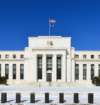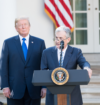Federal Reserve Chairman Jerome Powell delivered a highly anticipated speech at the National Association for Business Economics Annual Meeting, marking his first public address since last week’s inflation report. Powell struck a cautiously optimistic tone, discussing the Fed’s recent monetary policy moves and the broader economic outlook.
Powell began by acknowledging the recent economic progress, stating, “Our economy is strong overall and has made significant progress over the past two years toward achieving our dual-mandate goals of maximum employment and stable prices.”
- He pointed to a robust labor market and inflation that, according to new data, is slowing faster than anticipated. The Personal Consumption Expenditures (PCE) report for August showed that inflation was moderating, giving the Fed additional room to adjust its policies.
Rate Cut: One of the key highlights of Powell’s speech was the Federal Open Market Committee’s (FOMC) decision to cut interest rates by 50 basis points during their last meeting. Powell explained the rationale behind the move, stating, “That decision reflects our growing confidence that, with an appropriate recalibration of our policy stance, strength in the labor market can be maintained in an environment of moderate economic growth and inflation moving sustainably down to our objective.”
- This rate cut signals the Fed’s belief that the economy can achieve lower inflation while sustaining a strong job market.
Labor Market: Powell was positive but realistic, noting that while the job market remains solid, conditions have cooled compared to previous years. “Many indicators show the labor market is solid,” he said. However, he acknowledged that workers are now seeing fewer job openings compared to 2019.
- The moderation in job growth, combined with increased labor supply, has pushed the unemployment rate up to 4.2%, still low by historical standards. Importantly,
- Powell emphasized that further cooling in the labor market was not necessary to achieve the Fed’s 2% inflation target.
Inflation: Powell noted encouraging signs of progress, citing the recent PCE data. “Disinflation has been broad-based, and recent data indicate further progress toward a sustained return to 2 percent,” he said. Core goods prices have fallen by 0.5% over the past year, a reflection of easing supply chain issues. Core services inflation, outside of housing, is also nearing pre-pandemic levels.
- However, Powell acknowledged that inflation in housing services remains stubborn. “Housing services inflation continues to decline, but sluggishly,” he remarked, pointing to slow growth in rents as a positive indicator. As long as new rent increases remain modest, Powell expects housing inflation to continue to fall.
Looking Ahead: Powell reaffirmed the Fed’s commitment to data-driven decisions, avoiding any preset path for future rate adjustments. “Looking forward, if the economy evolves broadly as expected, policy will move over time toward a more neutral stance. But we are not on any preset course. The risks are two-sided, and we will continue to make our decisions meeting by meeting,” he said.
Bottom Line: Powell struck a balanced note, affirming the Fed’s readiness to use its tools to support the economy. “Overall, the economy is in solid shape; we intend to use our tools to keep it there,” he emphasized, leaving open the possibility of further adjustments as new data becomes available.



